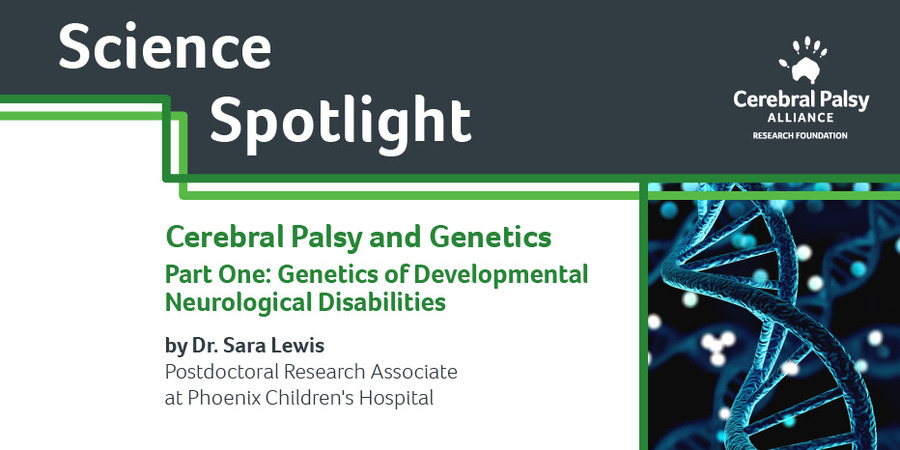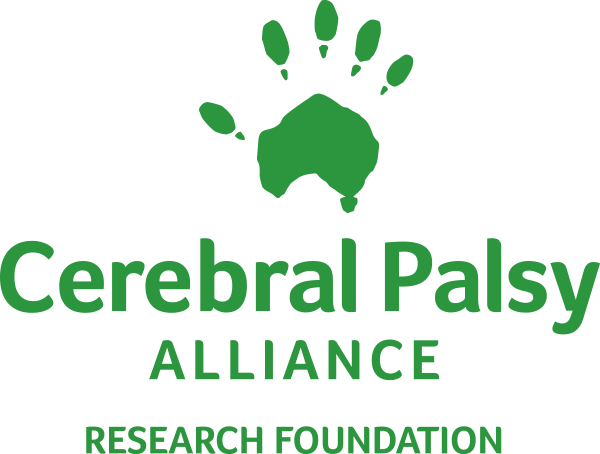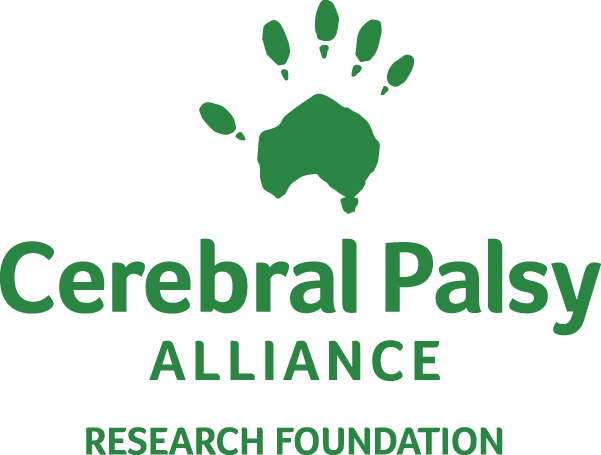
Science Spotlight: Cerebral Palsy and Genetics
Part One: Genetics of Developmental Neurological Disabilities
By Dr. Sara Lewis
This five-part series will discuss what is known about the genetic contributions to cerebral palsy and why finding and studying these genes is important.
When we hear the word “genetics,” we have flashbacks to the pea plants and funny grids from science class. In human genetics, we often think about changes in the genetic code. Each gene is represented by a sequence of DNA, with each DNA base indicated as a letter: A,T,G,C. Sometimes, the misspelling of a single letter can cause disease. We often overlook the fact that every DNA letter, collectively called the genome, is being copied every time a cell divides, which creates numerous chances for errors.
A change in the genetic code is called a mutation, or a variant. New variants can also happen when creating eggs or sperm. If this is passed on to a child, this is called a “de novo” variant, and these types of mutations are found more often in individuals with neurodevelopmental brain disorders such as intellectual disability, autism, epilepsy. Recently, an increased number of de novo mutations were also found in individuals with cerebral palsy.
While most variants will not create substantial changes in the function of the protein or important processes in the cells and organs, some mutations do disrupt function. A variant that causes disease is referred to as “pathogenic.” When we do not know what the relationship is between the genetic changes and a disease, disorder, or disability, variants are called “variants of uncertain significance.” There are also benign variants that do not change protein function in a problematic way.
The study of genetics can become more complicated when there isn’t a one gene-one trait relationship. Sometimes what causes a disability is a copy number variant — a deletion or duplication of a small part of the genome often involving multiple genes. Other traits are polygenic, meaning that multiple genes contribute; height is a common example of this type of trait. The genetic contributors to polygenic traits can be hard to identify because you must study tens of thousands of people.
Finally, some variants may confer risk, but not cause disease 100% of the time. In some cases, there might be an interaction between a gene and the environment. This might look like a sensitivity to a triggering event or exposure. One example is COL4A1, a collagen gene with variants creating an elevated risk for stroke or brain bleeds. Someone with these variants might be more sensitive to a brain bleed after an accident or injury, but they may not know they have a variant that increases their risk until after they’re injured.
All of these types of genetic contribution are potentially important in cerebral palsy and other conditions of brain development. Some children develop cerebral palsy with no exposure to environmental risk factors and may have a pathogenic gene variant. Other children may have a mild exposure, but develop a severe disability, and may therefore have a gene variant that increased their sensitivity or risk. And some genetic factors may be hard to pinpoint because they have not been described before or there are multiple contributing factors.
Part Two of this discussion will cover how cerebral palsy genetics are studied by scientific and clinical researchers.
About the Author: Dr. Sara Lewis is a Postdoctoral Research Associate at Phoenix Children’s Hospital working with Dr. Michael Kruer to identify genetic causes of cerebral palsy. She received her PhD in Neuroscience in 2015 with an emphasis in genetic neurodevelopmental disorders. Her work integrates human genetics with the fly model to study how genes leading to movement disorders changes in the brain. Her work also addresses the challenges implementing genetics findings in the clinical environment. Her research is funded by CPARF.
Tue 16 Jul 2024
By Kim Greene Season of Confirmation With his affirmative comment and now wondering if indeed I had a neurological issue, I googled what I knew about my history. I knew that I had been adopted and born eight weeks early and had to be kept in the hospital until I was stable and weighed more […]
Wed 10 Jul 2024
Cerebral Palsy Alliance Research Foundation (CPARF) and CVI Now (part of the CVI Center at Perkins School for the Blind) are hosting a joint event on Thursday, July 25 from 5:30 pm to 6:30 pm ET. Launching CPARF’s new “CP &…” series, the event will dive deep into the connections between cerebral palsy (CP) and […]





